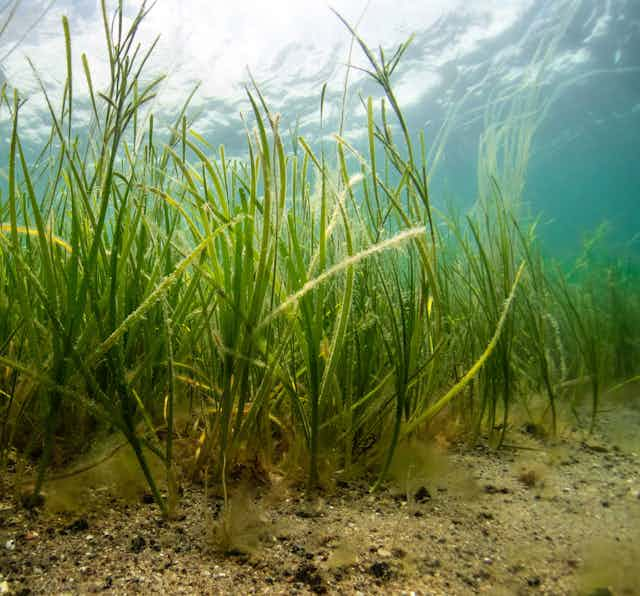Thousands of people took to the UK’s seas and rivers recently in a nationwide “paddle-out” protest to demand an end to sewage spilling into the country’s waterways. The campaigners were largely concerned about the consequences of this filth for human health and nature.
But as the UK’s coastal seas boil under what is an unprecedented marine heatwave, these calls have new urgency. At the time of writing, some areas off the coast of England are up to 5°C warmer than usual.
The degradation of the UK’s rivers and coasts caused by pollution, coupled with the impact of marine heatwaves, poses a threat to the future of a vital coastal plant species called seagrass.
Seagrasses are plants that have adapted to live in the ocean, forming vast meadows that often span hundreds of hectares. These meadows provide habitats for marine wildlife and nurseries for commercially important species such as Atlantic cod. They also trap carbon from our atmosphere, help reduce coastal erosion and even filter harmful bacteria from seawater.
But unlike humans, plants cannot control their body heat. So higher seawater temperatures lead to increased respiration rates (the process living things use to create energy to live and grow) and a greater need for food.
A higher respiration rate is not necessarily a problem for seagrass if it has lots of light to photosynthesise effectively. The problem is that light is often limited in polluted waterways.
Stopping the flow of pollution into our rivers is no longer a luxury for another day, but an urgent necessity. Failing to clean up our water systems now will result in the loss of marine and aquatic life, undermining the functioning of our natural world.
Algal growth
Seagrasses also need a supply of nutrients like nitrate and phosphate, without which they will be unable to grow. In UK waterways, the discharge of sewage and farming waste into rivers and streams, and the excessive use of fertilisers on the land contributes to elevated nutrient levels. However, these increased nutrient levels stimulate the growth of various types of algae in seawater, including those in the water, on seagrass leaves and on sediments.
This competition for nutrients puts seagrass at a disadvantage. Seagrasses primarily extract nutrients directly from the sediment, while algae can access them in the water more effectively.
As nutrient concentrations rise, algae populations continue to increase and form extensive blooms. The proliferation of algae turns the water green, covers the seagrass leaves and smothers the habitat. This overload of algae prevents seagrass from photosynthesising at such a rapid rate.
During a marine heatwave, seagrass experiences elevated respiration rates, which increases their need for light. In clear and healthy water, seagrasses respond by raising their photosynthetic rate to meet their additional energy requirements. However, when the water becomes overwhelmed by excessive algae growth, seagrass struggles to keep pace and eventually deteriorates.

Seagrass is suffocating
The UK’s waterways and coastal seas are some of the most heavily polluted in Europe. Over 75% of the country’s rivers and streams contain levels of organic pollutants that are either lethal to aquatic life or have the potential to cause chronic harm.
However, nutrient pollution affects seagrass far beyond the boundaries of the UK. In 2021, one study estimated that 88% of seagrass meadows worldwide are exposed to nutrient inputs from wastewater.
Over the past two years, we’ve been documenting the health of seagrass meadows around the UK at Project Seagrass (a marine conservation charity dedicated to saving the world’s seagrass) and Swansea University. This research adds to a database initially published in 2016.
Despite being located in marine protected areas, most of the seagrass meadows we have studied are in “poor” condition. The levels of nitrogen recorded in these meadows are up to 75% higher than the global average.
By analysing seagrass leaves for nutrients, including nitrogen and a stable isotope of nitrogen called 15N, we can identify the sources of these nutrients. Notably, sewage and livestock waste exhibit higher levels of 15N compared to other nutrient sources. These results support our suspicion that the excess nitrogen found in seagrass primarily originates from sewage discharges and nutrients running off farmland.

Costly pollution
Interestingly, seagrass meadows can also play a crucial role in controlling nutrient pollution. Research has demonstrated the significant financial value of seagrass meadows in terms of their capacity to absorb and store nutrients.
For instance, a study in Sweden observed that the loss of 1,000 hectares of seagrass over a 20-year period resulted in the release of 60,000 Mg of nitrogen back into the environment. This nitrogen release was more than three times the annual nitrogen load carried by rivers to Sweden’s north-west coastline.
The economic cost associated with this nitrogen release was estimated to be over US$140 million (£110 million). This calculation accounted for the expense required to meet the nitrogen reduction targets set by the EU Water Framework Directive, which includes things like the cost of building new wastewater treatment plants.
The loss of seagrass due to more intense marine heatwaves could exacerbate the ongoing deterioration of European waters. In our view, addressing water pollution, specifically from fertilisers and sewage, is just as urgent as tackling the climate and biodiversity crises.
Although we cannot accurately predict the intensity, duration and location of severe marine heatwaves, it seems that they are becoming more frequent as our climate system collapses. The only line of defence for the natural world against the rapidly changing climate is to make species and habitats more able to resist and recover from extreme events. This will require a fundamental change in the polluting practices that currently suffocate aquatic environments.

Don’t have time to read about climate change as much as you’d like?
Get a weekly roundup in your inbox instead. Every Wednesday, The Conversation’s environment editor writes Imagine, a short email that goes a little deeper into just one climate issue. Join the 20,000+ readers who’ve subscribed so far.

